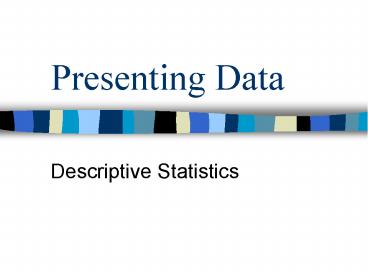Presenting Data - PowerPoint PPT Presentation
Title:
Presenting Data
Description:
Presenting Data Descriptive Statistics Nominal Level No order, just a name Can report Mode Bar Graph Pie Chart Ordinal Level Rank order only Can Report Mode Median ... – PowerPoint PPT presentation
Number of Views:297
Avg rating:3.0/5.0
Title: Presenting Data
1
Presenting Data
- Descriptive Statistics
2
Nominal Level
- No order, just a name
- Can report
- Mode
- Bar Graph
- Pie Chart
3
Ordinal Level
- Rank order only
- Can Report
- Mode
- Median
- Percentiles
- Histograms and Pie Charts
4
Interval/Ratio Level
- Equidistant
- Can Report
- Mode, Median, Mean
- Standard Deviation
- Percentiles
- Frequency curves, Histograms
5
Univariate Data
- Good to start at the univariate level
- Univariate one variable at a time
- Investigate the responses
- Assess usability for the rest of the analysis
6
Frequency Table
- Shows how often each response was given by the
respondents - Most useful with nominal or ordinal
- Interval/ratio has too many categories
- In Minitab, Select StatgtTablesgtTally
7
Charts and Graphs
- Use a bar graph or pie chart if the variable has
a limited number of discrete values - Nominal or ordinal measures
- Histograms and frequency curves are best for
interval/ratio measures - In Minitab, Select Graph gt (and then type)
8
Normal Curve
- The normal curve is critical to assessing
normality which is an underlying assumption in
inferential statistical procedures - And in reporting of results
- Kurtosis related to the bell-shape
- Skewness symmetry of the curve
- If more scores are bunched together on the left
side, positive skew (right) - If most scores are bunched together on the right
side, negative skew
9
Normal Curve
- To get a statistical summary, including an
imposed normal curve in Minitab - Select Stat gt Basic Statistics gt Display
Descriptive Statistics gt Graph gt Graphical Summary
10
Measures of Central Tendency
- Mode most frequently selected
- Bimodal two modes
- If more than two modes, either multiple modes or
no mode - Median halfway point
- Not always an actual response
- Mean arithmetic mean
11
Percentiles
- The median is the 50 percentile
- A percentile tells you the percentage of
responses that fall above and below a particular
point - Interquartile range 75th percentile 25th
percentile - Not affected by outliers as the range is
12
Z-scores
- Standard deviations provide an estimate of
variability - If scores follow a normal curve, you can
comparing any two scores by standardizing them - Translate scores into z-scores
- (Value mean) / standard deviation
13
Statistical Hypotheses
- Statistical Hypotheses are statements about
population parameters. - Hypotheses are not necessarily true.
14
In statistics, we test one hypothesis against
another
- The hypothesis that we want to prove is called
the alternative hypothesis, Ha. - Another hypothesis is formed which contradicts
Ha. - This hypothesis is called the null hypothesis,
Ho. Ho contains an equality statement.
15
Errors
16
P-value
- The choice of is subjective.
- The smaller is, the smaller the critical
region. Thus, the harder it is to Reject Ho. - The p-value of a hypothesis test is the smallest
value of such that Ho would have been
rejected.
17
Interval Estimates
- Statisticians prefer interval estimates.
- Something depends on amount of variability in
data and how certain we want to be that we are
correct. - The degree of certainty that we are correct is
known as the level of confidence. - Common levels are 90, 95, and 99.
18
Statistical Significance
- Statistically significant if the probability of
obtaining a statistic by chance is less than the
set alpha level (usually 5)
19
P-value
- The probability, computed assuming that Ho is
true, that the test statistic would take a value
as extreme or more extreme than that actually
observed is called the p-value of the test. - The smaller the p-value, the stronger the
evidence against Ho provided by the data. - If the p-value is as small or smaller than alpha,
we say that the data are statistically
significant at level alpha.
20
Power
- The probability that a fixed level alpha
significance test will reject Ho when a
particular alternative value of the parameter is
true is called the power of the test to detect
that alternative. - One way to increase power is to increase sample
size.
21
Use and Abuse
- P-values are more informative than the results of
a fixed level alpha test. - Beware of placing too much weight on traditional
values of alpha. - Very small effects can be highly significant,
especially when a test is based on a large
sample. - Lack of significance does not imply that Ho is
true, especially when the test has low power. - Significance tests are not always valid.































